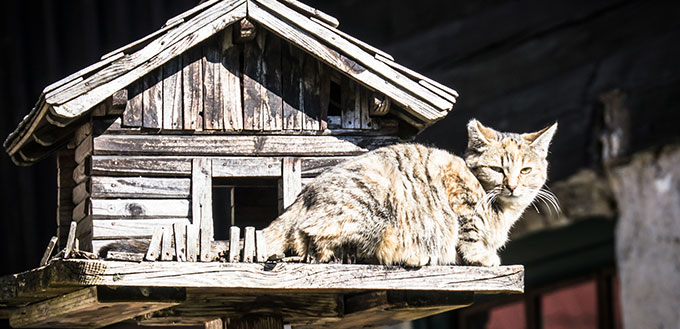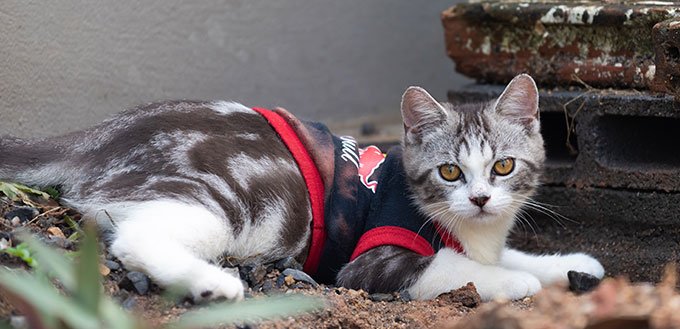For animal lovers, sharing your home with as many different animals as you can afford is one of life’s greatest joys. It might be a lot of work, and more than a little chaotic, but the experiences and the affection you receive is more than worth it! You need to be responsible, however, as there are lots of animals that might not naturally get along. Cats and birds are one such pair, and if you want to avoid having a Sylvester and Tweetie Pie situation, you need to learn how to stop your cat attacking your bird.
The Relationship Between Birds and Cats
Generally, birds and cats have a simple relationship. Cats are carnivorous predators and birds are potential prey. This means that having a cat might put your bird’s life in danger. Your cat will instinctively want to hunt your bird for fun. They might sit and watch them, stalk them, strike at them, or even pounce at them. If you allow this behavior to continue, it is likely that your cat will eventually catch and kill your bird.
Death resulting from violence isn’t the only concern. Birds can also die from the fear of being watched, stalked, or pounced at. Stress is a huge problem for birds, as it can cause issues such as:
- Suppression of the immune system
- Feather growth problems
- Death
A bird in a cage can still get stressed. Perhaps more so as they are unable to move away from the cause of their stress. This means that a cage is not a one-stop fix for protecting your bird.
Related Post: Best Bird Cage
Small birds are particularly at risk from such problems. It is worth remembering that there are many different species or birds, and therefore many different kinds of cat-bird relationships. In the wild, many are even predators, just like cats! While it is very unlikely that you have a pet hawk or eagle, you might have a parrot.
If you have a cat and parrot, you might not have to worry too much about your cat hunting and killing them. A huge bird, like a Macaw, does not look much like prey to normal house cat. There may still be fights and scuffles, however, so it may be helpful to look into this advice, even if your bird’s life isn’t in obvious or immediate danger.
Cat saliva also poses a potential health risk to all birds, regardless of their size. Their saliva can pass on bacteria that can cause infection and illness. Saliva from all mammals, including humans, pose a danger as they carry ‘gram negative’ bacteria, which birds’ bodies cannot handle, so it is also a good idea to avoid giving them little kisses.

How to Keep Cats Away from Birds
For their own safety, you must keep your birds away from your cats when they are unsupervised. This is an absolute necessity while you are training the cats not to view your birds as prey, but it is also a good idea afterwards. Even well-trained, calm, or old cats might have lapses in judgement. To help you do this, here are some tips:
- Cage Location
A cage is the first line of defence against an attack, but it can also be a source of anxiety, and has to be in a secure place. The cage itself should be stainless steel or powder-coated with less than 0.5 inches between the bars, or maybe smaller if your cat is still a kitten. It should be high off the ground and stable, so that your cat cannot knock it down to gain access to the bird. A heavy cage will also help with this. You should also put it in a safe location, where your cat cannot climb to reach the bird, and with no nearby perches that your cat could use as a launching pad to distress the bird.
Related Post: Best Cat Window Perches
- Isolation
If you are wondering how to keep a cat away from a bird cage when you are not around to supervise, the best method is to keep them in separate rooms. If you don’t work from home, this is likely to necessary for long periods of time, so you should make sure their respective comforts are in these different areas of the house. This includes their beds, litter trays, scratching posts, food and water.
Related Post: Best Cat Litter Boxes
You should also cover your bird’s cage while you area away. This is another method to keep your cat away as your cat is then less likely to obsess over something that they can’t see. This is also useful for keeping your bird calm, as, even if your cat is in a different room, other events that they may be able to see, such as through a window, could also distress them.
Permanent isolation is not good for either animal, so end the separation as soon as you are home by letting them into shared living spaces. This way they can both socialize with you. Obviously, you should keep a close eye on them.
You May Also Like: Bird Cage Covers
- Prevent Jealousy
Cats may also lash out at your bird if they feel neglected. Don’t let your cat think you have a new favorite. Continue to play with them and give them plenty of attention. Spend time grooming them, relaxing with them, and generally chatting. In particular, it is a good idea to satisfy her hunting urges using toys. This will, hopefully, mean they are too busy and satisfied to seek excitement by attacking your other pets and family members.
If you need help finding Toys for Cats and Interactive Cat Toys, take a look at our buying guides for support and recommendations.

How to Stop Your Cat From Attacking Your Bird
Prevention is a great method of keeping your bird safe, but supervision and isolation, while necessary, are not the only solutions. If you want to be able to briefly pop into another room to grab something, or allow yourself to get absorbed into a great TV show, you can also try training your cat not to attack your bird. Here are four steps to encouraging your cat to live harmoniously with your bird:
- Introductions
No matter which animal belonged to you first, when you bring home your new family member you should make it a point to introduce them to one another in a safe environment. Your cat will be curious, even if they are not hostile, and it is better to allow this to happen under your control than to allow your cat to terrify your bird.
Keep your bird in their cage during introductions, and make sure your cat is not in an aggressive mood. It is most important that your cat has the opportunity to smell their new friend to become more accustomed to their scent being present in your home. If your cat reaches towards the bird, or exhibits any other undesirable behavior, respond ‘No’ and take the cage out of sight and reach.
You should do these introductions a few times, but be realistic about your aims. It is extremely unlikely that you are going to be able to override thousands of years of evolution. But, you can try and aim that your cat is totally bored and uninterested in your bird, therefore keeping them safe.
- Distraction Training
As soon as your bird cage is set up in a safe location, you should get to work preparing for your cat to try investigating the cage. The best way to respond to this is to distract your cat from the cage when you are not deliberately initiating an introduction opportunity. Interactive toys are perfect for this, such as a mouse on a string.
You should keep the toy hidden on you whenever the three of you are in the same room. Then, whip it out to distract them if your cat moves to investigate the cage. By doing this, you are directing their urge to hunt the bird, to a ‘correct’ behavior of hunting the toy. Food puzzles offer a similar redirection.
It is a good idea to avoid using any toy that is reminiscent of a bird, to avoid causing any confusion. Generally, you should throw out any such toys. This includes toys with feathers, or that make ‘tweety’ noises. You want to do everything you can to discourage your cat’s hunter’s interest in your bird.
- Clicker Training
You can train cats using similar methods that are used to train dogs. Cats enjoy training as they enjoy utilizing their intelligence. It can, however, be more difficult to convince a cat to train with you. If you can get your cat to train, it may be worth investing in a clicker. Clickers are used to more accurately communicate with your cat when they are exhibiting desirable behavior.
You might use a clicker to keep your cat away from the areas where the bird cage is kept. Try doing sessions in which you reward your cat with a click and a treat when they are walking away from the cage, and offer them nothing when they walk towards the cage. You can also seek the help of a professional behaviorist if you are unsure of the best training method for your cat.
It is important not to punish your cat when you are trying to condition their behavior. This means you shouldn’t use squirt bottles or yelling. These techniques are more likely to harm the bond of trust between you and your cat than help with training.
- Emergencies
Unfortunately, your cat may go after your bird when your back is turned. There is a big difference between yelling with the goal of punishing, and loudly saying your cat’s name, and when an emergency occurs, the best thing to do is call them firmly and clap your hands. This should be enough to distract them from what they are doing, so that you can swoop in and stop whatever they were about to do. You must then remove them from the room.
Source:
- Ask Elizabeth: Help! My Cat’s a Killer; What Can I Do?, Cornell University College of Veterinary Medicine







My cat is always jumping on the cage I do this instructions but it does not work, today an incident happened my bird flew out of the cage while I was changing his newspapers and the cat almost got him I tried clapping and saying it’s name loud but it wouldn’t so a broom was nearby and I shood it away, Thankfully my bird is safe, but I really do need help because I don’t know what i’ll do if he gets my bird so please if anyone has any ideas please tell me, Thanks